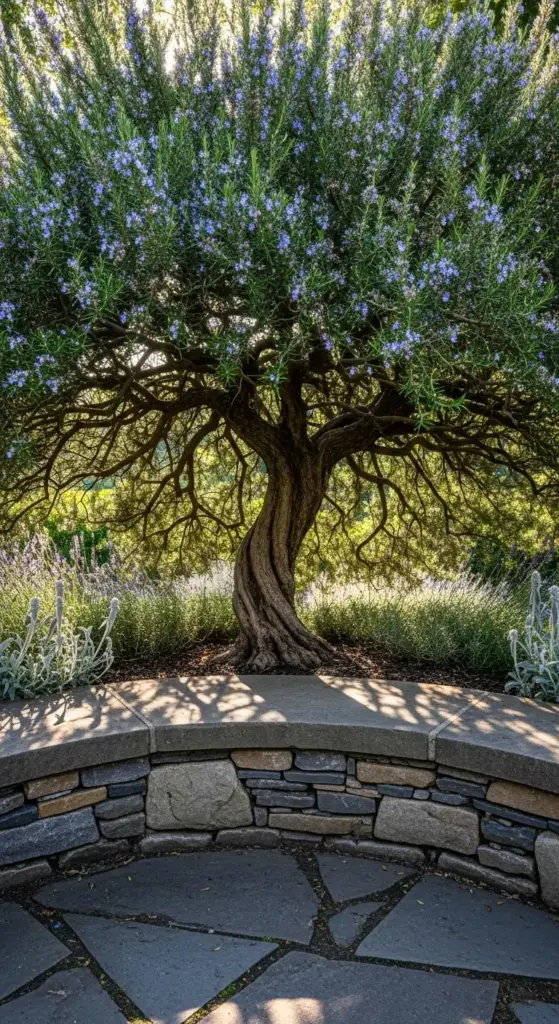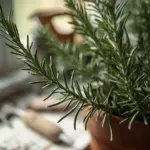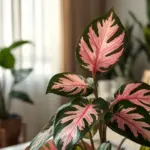5. The Contemplation Circle: Central Rosemary Focal Points

I used to have this boring patch of grass right in the center of my backyard that nobody ever used. It was just… there, taking up space and adding zero personality to my garden.
Then I discovered the power of contemplation circles during a visit to a Benedictine monastery in California. The way they used massive rosemary specimens as focal points was absolutely breathtaking.
That visit changed my entire approach to garden design. Now my backyard has this incredible centerpiece that draws people in and creates the most peaceful atmosphere.
Creating Dramatic Sculptural Centerpieces
The key to rosemary focal points is thinking big – way bigger than you’re probably comfortable with at first.
I started with a single ‘Tuscan Blue’ rosemary that was already 4 feet tall when I planted it. Yeah, it cost $85, but it instantly transformed the entire space.
Here’s what I learned about specimen plants – buy the biggest, most established rosemary you can afford. Small plants take 3-4 years to create real impact.
Training sculptural rosemary requires patience and vision. I use bamboo stakes to guide the main branches into interesting shapes during the first two years.
My centerpiece rosemary is now 7 feet tall and 6 feet wide, with this gorgeous twisted trunk that looks like it’s been growing there for decades.
For even more drama, I’ve seen people use multiple large rosemary plants arranged in a triangle or pentagon pattern. Creates this forest-like effect that’s absolutely stunning.
Designing Circular Beds That Draw the Eye
Circular garden design is trickier than it looks – I definitely made some proportion mistakes my first time around.
The circle needs to be big enough to feel substantial but not so large it overwhelms your space. My main contemplation circle is 16 feet across, which works perfectly for my half-acre lot.
I use a center stake and rope method to mark perfect circles. Pro tip – walk around the marked circle before you start digging to make sure it feels right from all angles.
Raised circular beds work better than ground-level ones because they create more visual impact. I built mine 18 inches high using natural fieldstone.
The pathway leading to the circle is crucial – I created a 4-foot wide curved path that approaches from the southeast, so morning light hits the rosemary perfectly.
Don’t make my mistake of centering the circle in your yard. Offset placement creates more interesting sight lines and feels more natural.
Incorporating Seating for True Contemplation
A contemplation circle without seating is just a fancy planting bed. The seating is what makes it functional and inviting.
I built a curved stone bench that follows about one-third of the circle’s perimeter. It seats three people comfortably and faces the main rosemary specimen.
Bench height matters – I made mine 18 inches high, which is perfect for most adults. Too low and it’s uncomfortable, too high and your feet dangle.
The bench material should complement your rosemary – I used the same fieldstone as the raised bed border to create visual continuity.
For smaller spaces, a single meditation chair or even a large flat boulder can work as seating. The key is having somewhere to sit and actually enjoy the space.
I added a small side table made from a tree stump for setting down coffee cups or books. Sometimes the simple additions make the biggest difference.
Complementary Plants That Enhance Rosemary
Pure rosemary circles can feel a bit stark, so I learned to add companion plants that enhance rather than compete.
Lavender varieties are perfect secondary plants – I use ‘Hidcote’ and ‘Munstead’ planted in small groups around the main rosemary specimen.
Silver-leafed plants create gorgeous contrast against rosemary’s deep green foliage. Lamb’s ear and dusty miller work beautifully as understory plants.
Ornamental grasses add movement and texture. I planted fountain grass and feather reed grass at strategic points around the circle’s edge.
For seasonal color, I tuck in some Mediterranean bulbs like alliums and grape hyacinths. They bloom in spring before the rosemary really takes off.
Avoid anything too flashy or colorful – the rosemary should remain the star. Subtle, complementary plants work best.
Year-Round Seasonal Interest
Maintaining year-round appeal in contemplation circles requires planning for all four seasons, not just spring and summer.
Spring interest comes from new rosemary growth and companion bulbs. I also added a few early-blooming perennials like hellebores for subtle color.
Summer is peak season when the rosemary flowers are in full bloom. The blue flowers against the silvery foliage is absolutely gorgeous.
Fall can be tricky because rosemary doesn’t have dramatic autumn color. I planted a few ornamental grasses that turn golden and provide movement in fall breezes.
Winter structure is crucial – the rosemary’s evergreen nature keeps the circle interesting even when everything else is dormant.
I added a few architectural elements like a small obelisk and some interesting rocks to provide winter focal points when plant interest is minimal.
DIY Projects for Custom Elements
Building your own contemplation circle elements is way more satisfying than buying everything, plus it saves serious money.
My curved stone bench was a weekend project using fieldstone from a local quarry. Total cost was about $120 versus $800 for a similar purchased bench.
DIY circular raised beds are easier than you think. I used a center stake and rope to mark the curves, then built up the walls with dry-stacked stone.
The trickiest part was getting the curves smooth – I had to adjust and readjust the stones multiple times before I was happy with the shape.
For the pathway, I used flagstone pieces fitted together like a puzzle. It took forever but looks way better than straight-edged pavers.
Custom planters for accent plants can be made from hypertufa (concrete and peat moss mixture). They develop this gorgeous weathered look after one season.
I built a simple wooden trellis for climbing jasmine using cedar posts and galvanized wire. It provides vertical interest and amazing fragrance in summer.
The whole contemplation circle project took about three months of weekend work and cost around $650 in materials. Best garden investment I’ve ever made.
Ready to maximize your garden space with stunning multi-level designs? Click “next” to explore terraced rosemary sanctuaries – these stepped garden techniques will help you create dramatic elevation changes that make even small yards feel like expansive Mediterranean hillsides!









GIPHY App Key not set. Please check settings